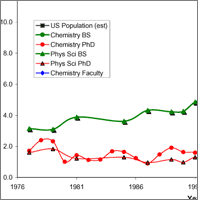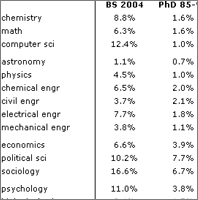Do We Need Julian Today?
Deep in the intricate country of the mind When speaking of the litany of race-based obstacles he faced—and faced down—throughout his long life, Percy Julian often quoted the poem above. "My dear friends," Julian once wrote, "who daily climb uncertain hills in the countries of their minds ... may I humbly submit to you, the only thing that has enabled me to keep doing the creative work was the constant determination: Take heart! Go farther on!" With the airing of "Forgotten Genius," the definitive account of his life to date, it seems like an opportune moment to ask to what degree the racism Julian endured still holds sway in the scientific world, 32 years after his death. To what extent does the color of one's skin affect one's advancement—or lack thereof—in the sciences?* And do we still need Percy Julian's example, marked by singular resolve, self-confidence, and ingenuity, to inspire young African-Americans to sidestep or squeeze through such barriers? For this article, I analyzed changes in the representation of blacks at measurable points in academia. I will let the data in the figures and tables at right speak for themselves, but it is clear that in most cases, the underrepresentation of African-Americans in science that was the norm throughout Julian's career has only marginally improved all these years later. And that to succeed in such a challenging environment, aspiring black scientists today will need to show the same fortitude and vision that Julian had to muster repeatedly to establish himself and succeed—to take heart and go farther on. One of my hopes is that the data supplied here will help African-American students visualize the landscape of science and engineering to optimize decisions regarding their professional lives, just as Percy Julian did. Degrees of disparityHow do we assess whether racial barriers still exist for African-Americans in science? One way is to see how the representation of blacks in the attainment of bachelor and doctoral degrees and faculty positions versus blacks' representation in the general population has changed since Julian's death in 1975. In Figure 1 (top illustration at right), the black line represents the change in percentage of blacks in the U.S. population since 1977, according to U.S. Census estimates. As you can see, that percentage has remained almost constant, increasing less than two percent, from 11.6 percent in 1977 to 13 percent in 2004. If all else were equal, one would expect the awarding of degrees to blacks to roughly match their representation in the general population. But that is not the case. For example, the proportion of B.S. degrees in the physical sciences awarded to blacks in 1977 was 3.1 percent (far left green triangle), which is in appalling disparity with the 11.6 percent black representation among the 1977 general population. Black representation among Ph.D. students was even worse: 1.6 percent in the physical sciences and 1.7 percent in chemistry in 1977 (far left red points). Even at first glance, the wide disparity in the gaining of degrees and faculty positions between blacks and white males is glaringly obvious. By 2004, things had improved, but not by much. While blacks received 6.2 percent of B.S. degrees in the physical sciences and 8.8 percent in chemistry that year (far right green points), they earned just 3.5 percent of all Ph.D.s awarded that year in the physical sciences and 4.1 percent in chemistry (far right red points). All of this is in a year in which blacks represented 13 percent (by a U.S. Census estimate) or 12.8 percent (by a U.S. Census sample) of the general population. Looking at the data most optimistically, blacks are making reasonably significant headway in advancing to lower degree levels in some disciplines, but less headway in advancing to higher degree levels. This trend continues in the representation of blacks among tenured and tenure-track faculty of "top 50" chemistry departments. Of these coveted positions, just 1.1 percent went to blacks in FY2001, 1.2 percent in FY2003, and 1.3 percent in FY2005 (blue diamonds). Thus, while progress of blacks at the faculty level is measurable, at the current rate of 0.05 percent per year increase, to reach parity with their 2004 representations among chemistry Ph.D. recipients, chemistry B.S. recipients, and the general population, it will take African-Americans over 56 years, 150 years, and 234 years, respectively. The rates of progress indicated in this graph seem too slow, particularly considering recent urgent appeals to increase rapidly the participation of U.S. citizens in science. Such appeals have appeared, among other examples, in the report of the U.S. Task Force on the Future of American Innovation, the National Academies' "Rising Above the Gathering Storm," the National Summit on Competitiveness, the American Chemical Society's calls to support science and technology innovation, President Bush's State of the Union Address, the American Competitiveness Initiative, actions of the U.S. Congress to bolster the National Science Foundation's education programs, and the National Science Board's "Science and Engineering Indicators 2006." Different ladders for different folksAnother way to determine to what degree African-Americans still face barriers to advancement in science is by examining the representation of blacks at various measurable points in their academic pipelines. Tables 1 and 2 compare data for blacks and for white males, respectively. Each table provides data for each discipline on progress up the "academic ladder," with representation among B.S. and Ph.D. recipients on the left and, on the right, representation among tenured and tenure-track professors at "top 50" departments, as ranked by the National Science Foundation according to research funding expenditures. Even at first glance, the wide disparity in the gaining of degrees and faculty positions between blacks and white males is glaringly obvious. But considering what this disparity might mean for young blacks hoping to succeed in academia, it's worth a closer look. For example, what do the data tell us about the availability of faculty role models and mentors for African-American students? The first row in Table 1 gives us some idea. Blacks represented 8.8 percent of chemistry B.S. recipients in 2004 and 1.3 percent of all chemistry professors at the FY2005 "top 50" chemistry departments. The ratio 8.8 percent to 1.3 percent—versus a corresponding ratio of 37.7 percent to 77.5 percent for white males—indicates that black chemistry majors do not enjoy the supply of same-race faculty role models and mentors that majority chemistry majors do. The scientific community has come a long way in accepting African-Americans—and, paradoxically, not remotely far enough. One can also analyze the tapping of the faculty hiring pool. During the period 1995-2004, blacks took 3.3 percent of all chemistry Ph.D.s, for example, which put them in an appropriate hiring pool for chemistry faculty hired during the period 1999-2005. Again, if all else were equal, one might expect to see about 3.3 percent of blacks among assistant professors in FY2005. But, as the table reveals, blacks represented only 0.7 percent of tenure-track assistant professors in "top 50" chemistry departments that year. A matter of disciplinesIt is extremely important to realize that scientific disciplines differ greatly in characteristics of their data. If, for example, being around people of the same race is important to a black student, then that student can use these tables as valuable sources of information when making academic and career decisions, such as which sciences to study and in which disciplines to make his or her professional home. Because science and engineering are so interdisciplinary today, one selection need not determine the other; students can study and research the science of interest to them while formally enrolled in any discipline. But the discipline in which one enrolls will determine the environment in which one studies and eventually works, so characteristics of science and engineering disciplines can prove useful in such decisions. In light of this, Figure 2 offers another view of the scientific landscape that is of potential value to black students. The graph offers a comparison of black Ph.D. attainment across scientific disciplines over the past 20 years. The comparison reveals disciplines in which a) blacks are currently best represented among Ph.D. recipients, b) black representation is increasing most rapidly, and c) black representation will therefore hypothetically reach parity with the general population soonest. The figure's legend lists disciplines in order of greatest increase in black Ph.D. attainment over the time period 1983-2004. It is obvious that some disciplines have seen spectacular advances over the past couple of decades, such as electrical engineering (thick blue line) rising from 0.7 percent in 1983 to 7.0 percent in 2004. Psychology, mechanical engineering, and economics (thick green, red, and black lines, respectively) also made significant strides over the same time span. Two disciplines, political science and sociology, had the highest representation of blacks among Ph.D. recipients throughout the two-decade period. Go farther on
If there is one thing that the data in these graphs and tables indicate
unequivocally, it is that the scientific community has come a long way since
Percy Julian's day in accepting African-Americans into its lower
ranks—and, paradoxically, not remotely far enough, especially at higher
levels. It is my hope that young blacks will use the data in this article and
other similar data—as well as Julian's inspiring example—to make
better-informed career decisions, to reach higher levels, and to sidestep or
pass through professional barriers, just as Julian did so masterfully in his
lifelong quest to "take heart" and "go farther on."
*Because this Web site concerns Percy Julian, I focus on African-Americans in this article, though one can ask the same questions, of course, about other underrepresented groups, such as Hispanics and Native Americans. |

Figure 1. This figure shows the change in percentage of blacks in the U.S. population, and in B.S. and Ph.D. degree attainment, between 1977 and 2004. It also shows the change in percentage of black faculty among "top 50" chemistry departments between 2001 and 2005. 
Tables 1 and 2. These tables, one for blacks and one for white males, show representation among B.S. and Ph.D. recipients, and tenured and tenure-track professors, in 15 scientific disciplines. 
Figure 2. This figure offers a comparison of black Ph.D. attainment across 15 science and engineering disciplines from 1983 to 2004. |

Dr. Donna Nelson is an associate professor at the University of Oklahoma, where she was the first tenure-track female professor ever hired into the Department of Chemistry. Part Native American, she is an expert on race and gender bias in science. She received the National Organization for Women's "Woman of Courage Award" in 2004 and was named the 2006 Distinguished Scientist of the Year by the Society for the Advancement of Chicanos and Native Americans in Science. Forgotten Genius Home | Send Feedback | Image Credits | Support NOVA |
© | Created January 2007 |
